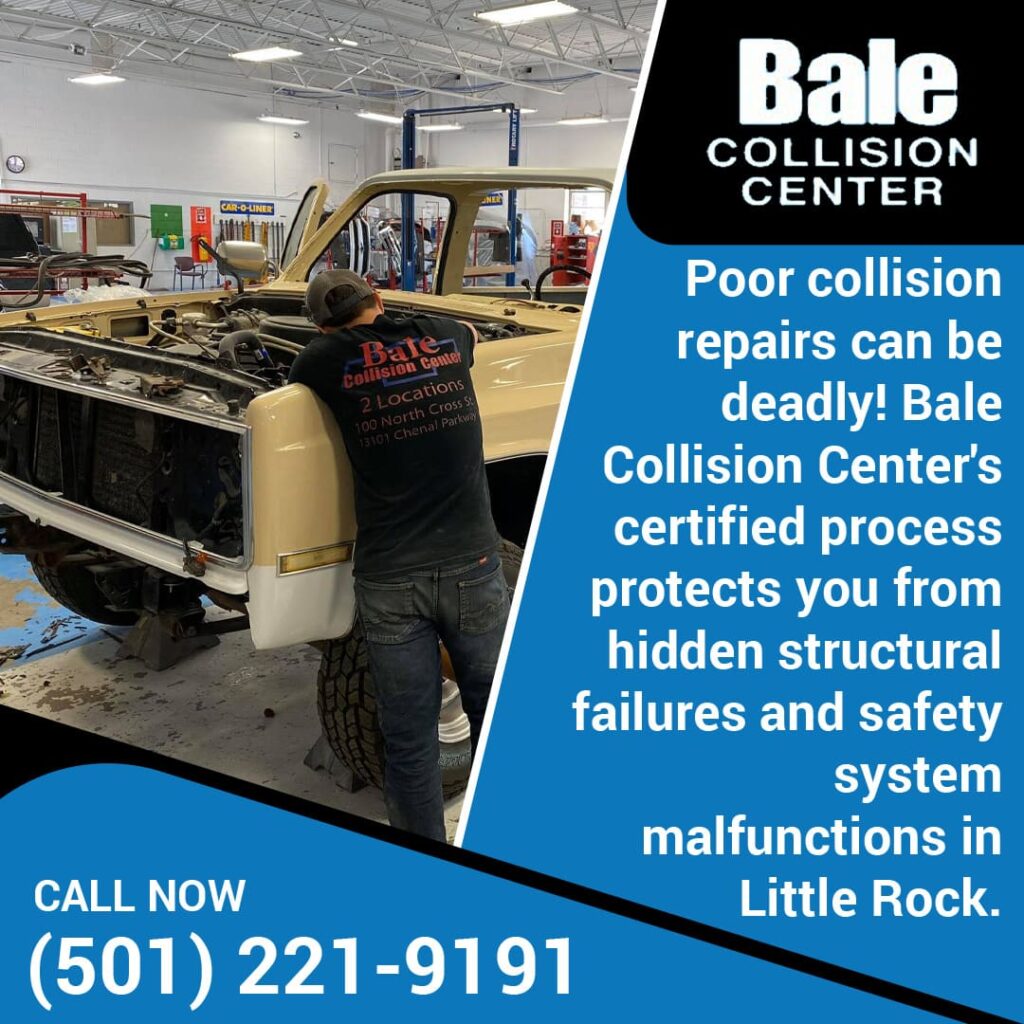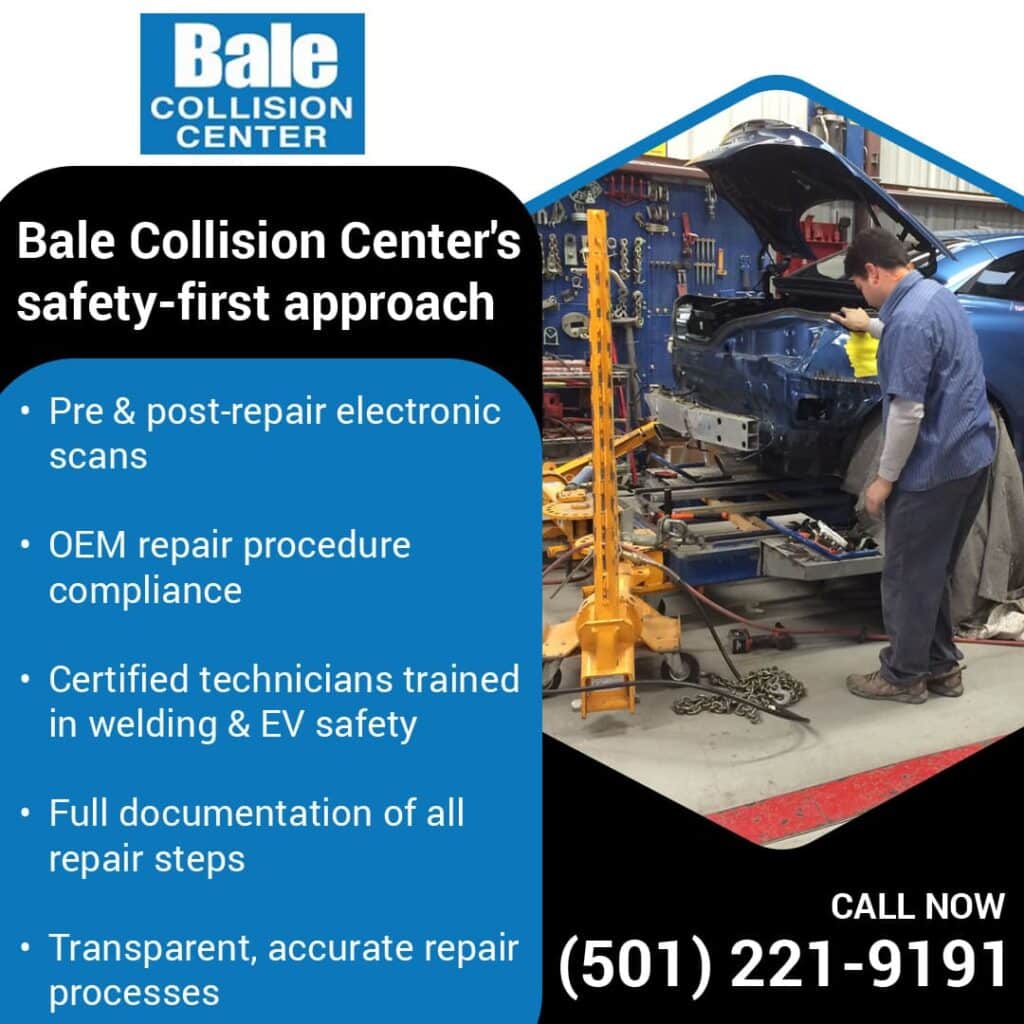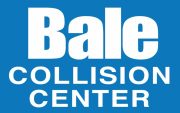When your vehicle suffers collision damage, the quality of repairs directly affects your safety. Poor auto collision repair work can turn your car into a dangerous vehicle that puts you and your family at risk. At Bale Collision Center (Chenal) in Little Rock, we have seen how bad repairs from unqualified shops create serious safety problems.
In 2017, a collision shop in Dallas was ordered to pay $31.5 million in damages for not following proper repair procedures. The improperly repaired Honda Fit was involved in a second accident that caused devastating burns and serious injuries to the occupants because the vehicle’s safety structure failed to protect them. This case shows why proper repair methods matter so much for your safety.
Our certified collision repair approach focuses on fixing vehicles the right way using manufacturer-approved methods. With over 70 years of experience and I-CAR Gold Class certification, we know that every repair decision affects how well your car protects you. Unlike collision centers that cut corners or lack proper training, we strictly follow OEM procedures to maintain your car’s ability to absorb crash energy and protect occupants during future accidents.

How Poor Collision Repairs Create Safety Hazards
Poor collision repairs create safety problems that you cannot see right away. These dangers develop when shops lack proper training, equipment, or commitment to following safety procedures.
Incorrect Welding Methods Weaken Your Car
Many auto collision repair shops use welding methods that make your vehicle weaker. Modern cars need specific welding patterns and techniques to stay strong. When shops skip these steps or use improper welding approaches, they create weak spots in your car’s safety structure.
Poor welding can make joints weaker. This means the parts of your car designed to protect you during a crash may not work properly. Instead of absorbing impact energy safely, these weak areas might fail and send crash forces toward you and your passengers.
Using Wrong Parts Creates Hidden Dangers
Some collision centers use cheap aftermarket parts or incorrect materials to save money. They might replace high-strength steel parts with regular steel or use heavy parts instead of lightweight aluminum components that your car was designed with.
These wrong parts change how your car handles crashes. A bumper made from the wrong material might send too much crash energy into the passenger area. Side impact beams made from incorrect materials might not protect you during side crashes.
Bad Paint Work Hides Structural Problems
Poor paint work can hide damage and cause rust that weakens important safety parts. Shops that rush paint work or use the wrong paint products create problems that let water get under the paint.
Over time, this hidden rust weakens the mounting points for seat belts, airbag sensors, and structural supports. What looks like good paint work might actually be covering up ongoing damage to safety parts.
How Poor Repairs Damage Electronic Safety Systems
Today’s cars have many control modules that must work together for safety systems to function. Poor repair work often breaks these connections, creating safety problems you cannot see.
ADAS System Damage
Advanced Driver Assistance Systems (ADAS) are safety features that help prevent accidents by monitoring your surroundings and assisting with driving tasks. These systems include automatic emergency braking, blind spot monitoring, lane keeping assist, and forward collision warning.
ADAS systems use cameras, radar sensors, and lidar sensors mounted throughout your vehicle. During collision repairs, these sensors can be damaged, moved out of position, or contaminated without triggering obvious warning lights on your dashboard.
For example, a radar sensor with paint particles on it might still work partially, giving you false confidence while failing to detect pedestrians or stopped cars. Lane departure cameras that are slightly misaligned might give wrong warnings or fail to work when you need them most.
Electronic Control Module Communication Breakdown
Car electronic modules talk to each other through data networks that can be damaged during collision repairs. When collision centers reconnect wiring incorrectly or forget to update software after replacing parts, they create communication gaps between safety systems.
For example, the airbag control module might lose contact with crash sensors, preventing airbags from deploying properly. Anti-lock brake systems might not get information from wheel sensors, removing stability control protection during emergency stops.
ADAS systems are especially vulnerable because they rely on constant communication between multiple control modules. If one module can’t communicate with the others, the entire safety system may stop working without warning you.
Electrical System Damage
Electric and hybrid cars face extra risks from shops that don’t understand high-voltage systems. Wrong handling of battery packs or charging systems can create fire hazards or electrical failures that damage multiple safety systems at once. Even regular cars suffer when shops damage alternators, wiring, or control modules during repairs, leading to electrical problems that disable lights, stability control, and other safety features.
Why Manufacturer Repair Procedures Matter
Car manufacturers don’t create repair procedures randomly. They develop these methods through extensive crash testing and engineering studies.
Engineering Validation and Testing
OEM (Original Equipment Manufacturer) repair procedures are validated using crash simulation, controlled crash tests, and other engineering verification methods that are the same or similar to those required for new car safety certification. This testing shows how different repair methods affect crash energy absorption, occupant protection, and structural strength. Only methods that pass these tough tests become approved auto collision repair procedures.
Material Requirements
Modern cars use dozens of special materials, each designed for specific properties like strength, flexibility, and energy absorption. Manufacturer procedures specify exactly how to work with these materials without damaging their protective characteristics.
For instance, certain aluminum materials lose their strength if heated too much during welding. Manufacturer procedures specify welding settings, cooling rates, and heat treatment requirements to keep material properties that protect occupants during crashes.
Structural Design
Car structures are designed with specific paths that direct crash energy around passenger areas. Manufacturer procedures maintain these engineered paths by specifying exact attachment points, joint designs, and structural supports. When car collision repair shops ignore these procedures, they accidentally redirect crash energy toward occupants instead of away from them.
Warning Signs of Inadequate Repair Practices
Certain red flags indicate that a repair shop may be cutting corners on safety-important repairs.
Extremely Low Prices
Estimates that are much lower than competitors’ may indicate planned shortcuts or cheap substitute parts. Quality repairs require specific procedures, trained technicians, and approved materials, all of which cost money. Shops that promise unrealistically low prices often plan to use non-manufacturer parts, skip calibration procedures, or use untrained workers who work faster but less safely.
Missing Diagnostic Equipment
Modern car collision repair requires sophisticated diagnostic and calibration equipment. Shops without pre-repair scanning abilities, safety system calibration tools, or manufacturer procedure access cannot perform safe repairs on today’s vehicles. Ask repair shops about their diagnostic abilities and calibration equipment. Good shops will gladly discuss their investment in proper tools and training.
Rushed Repair Times
Safety-focused repairs take time for proper procedures, parts ordering, and quality checks. Shops that promise unrealistically fast completion times often skip critical steps like proper drying times, multi-stage calibrations, or thorough testing. Quality car collision repair cannot be rushed without compromising safety. Proper procedures have minimum time requirements that cannot be shortened without risking your protection.
Long-Term Safety Risks
The problems from poor collision repairs extend far beyond the immediate repair period, creating ongoing safety risks that may go unnoticed.
Gradual Structural Failure
Improperly repaired structures may look fine at first, but develop cracks or fail over time. These gradual failures can suddenly compromise vehicle safety during normal driving conditions, not just during accidents. Metal fatigue from wrong welding procedures may cause seat belt mounting points to fail during emergency braking, while incorrectly attached panels may separate during high-speed driving or severe weather.
Safety System Decline
Incorrectly calibrated safety systems may work at first but become less accurate over time. Safety sensors with poor calibration may gradually become less reliable, while improperly connected control modules may develop intermittent communication failures. These decline patterns create unpredictable safety performance that leaves drivers unaware of compromised protection until a critical moment when systems fail to work as expected.
Insurance and Legal Problems
Cars repaired improperly may not meet insurance requirements for coverage continuation, while owners may face legal issues if bad repairs contribute to accidents or injuries involving other people. Documentation of proper repair procedures becomes important for maintaining insurance coverage and avoiding legal complications if vehicle safety becomes questioned after later incidents.

Bale Collision Center’s Safety-Focused Approach
At Bale Collision Center, our approach to collision repair in Chenal Parkway, Little Rock, AR, prioritizes the highest safety standards to protect you and your family.
Materials Training
Our I-CAR Platinum-certified collision repair technicians receive special training in materials and how different materials respond to repair processes. This knowledge prevents the material damage that compromises safety in poorly done repairs. We maintain welding certifications for all materials used in modern cars, including advanced high-strength steels, aluminum alloys, and mixed-material joints that require specific techniques to maintain their protective properties.
Electronic System Focus
Unlike collision centers that only fix visible damage, we focus on the invisible electronic networks that modern safety systems depend on. Our systematic approach to network checking catches communication failures that could disable critical safety features. We perform complete network scans both before and after repairs, documenting all system communications and checking proper operation of connected safety systems.
Complete Documentation
Every auto collision repair includes full documentation of procedures followed, calibrations performed, and testing completed. This documentation serves as proof that safety-critical repairs were done according to manufacturer specifications. Our certified collision repair process includes photos of damage assessment, repair procedures, and final testing, providing complete transparency and accountability for safety-related work.
Reliable Collision Repair in Chenal Parkway, Little Rock, AR
Vehicle safety depends on the repair quality that you cannot see or easily check after completion. The choice between certified collision repair and cheaper alternatives is ultimately a choice between proven safety and unknown risks.
Bale Collision Center’s commitment to proper procedures, advanced equipment, and certified training provides the confidence that your vehicle will protect you as originally designed. Our I-CAR Gold Class certification and 70 years of experience represent a safety investment that protects you and your family.
Don’t risk your safety by choosing collision repair based only on price. Poor repairs create hidden costs through compromised protection, potential system failures, and unknown long-term risks. These dangers far exceed any money saved up front.
For certified collision repair in Chenal Parkway, Little Rock, AR, contact Bale Collision Center today. Call us at (501) 221-9191 or email us at bccwlr@baleautomotive.com to schedule your free repair estimate. Your safety deserves the protection that only proper collision repair can provide.
